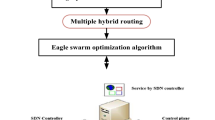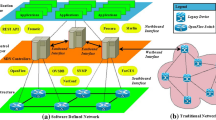Abstract
Network simulation and capabilities in the form of a logical network has increased the development of virtual networks rapidly. It is one of the best ways to increase productivity and optimize hardware equipment. Network-Virtualization plays a very important role in the development of networks as the size of the networks increases vastly. This paper examines one of the most important issues in network virtualization to provide an efficient dynamic resources infrastructure management on Software-Based Networks. The proposed method (cTMvSDN) improves resource management based on combination of Markov-Process and Time Division Multiple Access (TDMA) protocol. A customized module to the controller only initializes the mapping when there are sufficient available resources. In order to optimize the response time and SDN Quality of service, the Markov-Pattern and TDMA slicing model are used to predict the next time gaps. Successfully mapped packets will be sent in TDMA slots. Simulation results performed with NS2 and Mininet simulator showed improvement in metrics such as delay and costs in comparison with relevant studies in the literature.









Similar content being viewed by others
References
Nguyen V-G, Do T-X, Kim Y (2016) SDN and virtualization-based LTE mobile network architectures: a comprehensive survey. Wireless Pers Commun 86(3):1401–1438
Abuarqoub A (2020) A review of the control plane scalability approaches in software defined networking. Future Internet 12(3):49
Javadpour A, Wang G, Rezaei S (2020) Resource management in a peer to peer cloud network for IoT. Wireless Pers Commun 115(3):2471–2488
Chiha A, Van der Wee M, Colle D, Verbrugge S (2020) Network slicing cost allocation model. J Netw Syst Manag 28(3):627–659
Javadpour A (2020) Providing a way to create balance between reliability and delays in SDN networks by using the appropriate placement of controllers. Wireless Pers Commun 110(2):1057–1071. https://doi.org/10.1007/s11277-019-06773-5
Aglianò S, Ashjaei M, Behnam M, Bello LL (2018) “Resource management and control in virtualized SDN networks”, in 2018. Real-Time Embed Syst Technol (RTEST) 2018:47–53
Singh S, Jha RK (2017) A survey on software defined networking: architecture for next generation network. J Netw Syst Manag 25(2):321–374
Javadpour A, Wang G, Rezaei S, Li KC (2020) Detecting straggler MapReduce tasks in big data processing infrastructure by neural network. J Supercomput 76(9):6969–6993
Javadpour A, Kazemi Abharian S, Wang G (2017) “Feature selection and intrusion detection in cloud environment based on machine learning algorithms. In: 2017 IEEE international symposium on parallel and distributed processing with applications and 2017 IEEE international conference on ubiquitous computing and communications (ISPA/IUCC), pp 1417–1421
Javadpour A, Wang G, Li KC (2019) A high throughput MAC protocol for wireless body area networks in intensive care. In: Smart city and informatization, pp 23–34
Javadpour A (2019) Improving resources management in network virtualization by utilizing a software-based network. Wirel Pers Commun 106(2):505–519
Huang G, Youn HY (2020) Proactive eviction of flow entry for SDN based on hidden Markov model. Front Comput Sci 14(4):144502
Javadpour A, Wang G, Xing X (2018) Managing heterogeneous substrate resources by mapping and visualization based on software-defined network. In: 2018 IEEE Intl Conf on parallel distributed processing with applications, ubiquitous computing communications, big data cloud computing, social computing networking, sustainable computing communications (ISPA/IUCC/BDCloud/SocialCom/SustainCom), 2018, pp 316–321
Tayyaba SK, Shah MA (2019) Resource allocation in SDN based 5G cellular networks. Peer-to-Peer Netw Appl 12(2):514–538
Chen Q, Yu FR, Huang T, Xie R, Liu J, Liu Y (2016) Joint resource allocation for software defined networking, caching and computing. IEEE Glob Commun Conf (GLOBECOM) 2016:1–6
Zhang T, Liu B (2019) Exposing end-to-end delay in software-defined networking. Int J Reconfigurable Comput 2019:7363901
Yi B, Wang X, Huang M, Zhao Y (2020) Novel resource allocation mechanism for SDN-based data center networks. J Netw Comput Appl 155:102554
Amiri M, Al Osman H, Shirmohammadi S (2018) Game-aware and SDN-assisted bandwidth allocation for data center networks. In: 2018 IEEE conference on multimedia information processing and retrieval (MIPR), pp 86–91
Raddwan B, AL-Wagih K, Al-Baltah IA, Alrshah MA, Al-Maqri MA, (2019) Path mapping approach for network function virtualization resource allocation with network function decomposition support. Symmetry (Basel) 11(9):1–25
Mijumbi R, Serrat J, Rubio-Loyola J, Bouten N, Turck FD, Latré S (2014) Dynamic resource management in SDN-based virtualized networks. In: 10th International conference on network and service management (CNSM) and workshop, pp 412–417
Bremaud P (2013) Markov chains: Gibbs fields, Monte Carlo simulation, and queues. Springer, New York
Ibe O (2005) Fundamentals of applied probability and random processes. Elsevier, Amsterdam
Malepati H (2010) Digital media processing: dsp algorithms using C. Elsevier, Amsterdam
Mirmohseni SM, Tang C, Javadpour A (2020) Using Markov learning utilization model for resource allocation in cloud of thing network. Wireless Pers Commun 115(1):653–677. https://doi.org/10.1007/s11277-020-07591-w
Jafari F, Mostafavi S, Mizanian K, Jafari E (2021) An intelligent botnet blocking approach in software defined networks using honeypots. J Ambient Intell Human Comput 12(2):2993–3016
Acknowledgements
This work is supported in part by the National Natural Science Foundation of China under Grants 61632009 & 61472451, in part by the Guangdong Provincial Natural Science Foundation under Grant 2017A030308006 and High-Level Talents Program of Higher Education in Guangdong Province under Grant 2016ZJ01.
Author information
Authors and Affiliations
Corresponding author
Additional information
Publisher's Note
Springer Nature remains neutral with regard to jurisdictional claims in published maps and institutional affiliations.
Appendix—Script VNR Virtualizations
Appendix—Script VNR Virtualizations





Rights and permissions
About this article
Cite this article
Javadpour, A., Wang, G. cTMvSDN: improving resource management using combination of Markov-process and TDMA in software-defined networking. J Supercomput 78, 3477–3499 (2022). https://doi.org/10.1007/s11227-021-03871-9
Accepted:
Published:
Issue Date:
DOI: https://doi.org/10.1007/s11227-021-03871-9




